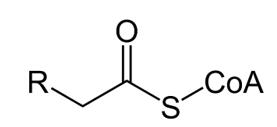What are Acyl-CoAs?
Cellular metabolism is a complex network of interconnected pathways that enable the generation of energy and the synthesis of essential molecules. At the core of these intricate processes are Acyl-CoAs, vital intermediates involved in various biochemical reactions. Acyl-CoAs are formed through the enzymatic conjugation of Coenzyme A (CoA) with an acyl group derived from fatty acids. Acyl-CoA synthetase enzymes play a pivotal role in activating fatty acids and facilitating their attachment to CoA. The resulting Acyl-CoAs are dynamic molecules with varying chain lengths, degrees of saturation, and functional groups.

The Importance of Acyl-CoAs in Cellular Metabolism
Acyl-CoAs play a crucial role as intermediates in various metabolic processes, including fatty acid oxidation, fatty acid synthesis, cholesterol metabolism, and ketogenesis.
Fatty Acid Oxidation: Acyl-CoAs are central to the process of fatty acid oxidation, which occurs primarily in the mitochondria. Acyl-CoA dehydrogenase enzymes catalyze the first step of β-oxidation, leading to the generation of Acetyl-CoA, NADH, and FADH2. This process breaks down fatty acids, releasing energy in the form of ATP.
Fatty Acid Synthesis: Acetyl-CoA derived from Acyl-CoAs serves as a building block for the synthesis of long-chain fatty acids. Acyl-CoAs are activated by Acyl-CoA synthetase enzymes and undergo a series of enzymatic reactions to form fatty acids. These fatty acids are crucial for the production of lipids, such as triglycerides, phospholipids, and membrane components.
Cholesterol Metabolism: Acyl-CoA cholesterol acyltransferase (ACAT) enzymes play a key role in cholesterol metabolism. ACAT utilizes Acyl-CoAs to esterify cholesterol, leading to the formation of cholesteryl esters. Cholesteryl esters are important for the storage and transport of cholesterol within cells and lipoproteins.
Ketogenesis: Acyl-CoAs are involved in the process of ketogenesis, which occurs during prolonged fasting or low carbohydrate intake. Under these conditions, Acyl-CoAs derived from fatty acids are converted into ketone bodies, including acetone, acetoacetate, and β-hydroxybutyrate. Ketone bodies serve as an alternative energy source, particularly for the brain and other organs during periods of limited glucose availability.
These metabolic processes highlight the diverse roles of Acyl-CoAs in energy metabolism, lipid synthesis, cholesterol homeostasis, and adaptation to fasting conditions. Understanding the intricate interplay of Acyl-CoAs in these pathways provides valuable insights into cellular metabolism and its implications for human health and disease.
Acyl-CoA Metabolism
Fatty Acid Oxidation: Unleashing Energy from Acyl-CoAs:
Fatty acid oxidation is a fundamental process for energy generation. It involves a series of enzymatic reactions that break down Acyl-CoAs into Acetyl-CoA units. Key players in this pathway include Acyl-CoA dehydrogenase, enoyl-CoA hydratase, and 3-ketoacyl-CoA thiolase. The liberated Acetyl-CoA can then enter the tricarboxylic acid (TCA) cycle for further energy extraction.
Fatty Acid Synthesis: Acyl-CoAs as Precursors of Complex Lipids:
Fatty acid synthesis is crucial for the production of lipids necessary for cellular structure and function. Acetyl-CoA, derived from Acyl-CoAs, serves as the building block for fatty acid synthesis. Key enzymes in this pathway include Acetyl-CoA carboxylase, fatty acid synthase, and various elongases and desaturases. The resulting long-chain fatty acids can be incorporated into glycerolipids, phospholipids, and sphingolipids.
Cholesterol Metabolism: The Role of Acyl-CoAs:
Cholesterol is a vital component of cellular membranes and serves as a precursor for various signaling molecules. Acyl-CoA cholesterol acyltransferase (ACAT) enzymes esterify cholesterol using Acyl-CoAs, forming cholesteryl esters that can be stored within cells or transported in lipoproteins. This process helps regulate cholesterol levels and maintain cellular homeostasis.
Other Metabolic Pathways Involving Acyl-CoAs:
Acyl-CoAs also participate in diverse metabolic pathways, including amino acid metabolism, ketone body production, and the synthesis of specialized lipids such as eicosanoids and isoprenoids. These pathways highlight the versatility and significance of Acyl-CoAs in cellular metabolism.
Acyl-CoA vs. Acetyl-CoA
Acyl-CoA and Acetyl-CoA are both important molecules involved in cellular metabolism, but they differ in their structure and specific roles within metabolic pathways.
Structure:
Acyl-CoA: Acyl-CoA is a general term that refers to a group of molecules consisting of an acyl group (a hydrocarbon chain) attached to coenzyme A (CoA) via a thioester bond. The acyl group can vary in length, saturation, and functional groups, depending on the specific fatty acid or other metabolite involved.
Acetyl-CoA: Acetyl-CoA is a specific type of Acyl-CoA in which the acyl group is a two-carbon acetyl group (-COCH3). The acetyl group is attached to coenzyme A via a thioester bond, similar to other Acyl-CoAs.
Role in Metabolic Pathways:
Acyl-CoA: Acyl-CoAs serve as key intermediates in various metabolic pathways. They are involved in fatty acid oxidation, fatty acid synthesis, amino acid metabolism, cholesterol metabolism, and the synthesis of specialized lipids. Acyl-CoAs act as carriers of acyl groups, enabling the transport and transfer of these groups between enzymes and substrates within metabolic reactions.
Acetyl-CoA: Acetyl-CoA is a central molecule in cellular metabolism and serves as a hub for energy production and biosynthesis. It is derived from the breakdown of glucose, fatty acids, and amino acids. Acetyl-CoA plays a crucial role in the tricarboxylic acid (TCA) cycle (also known as the citric acid cycle or Krebs cycle), where it enters as a substrate and undergoes a series of reactions to generate energy-rich molecules such as NADH and FADH2. Acetyl-CoA is also a precursor for the synthesis of fatty acids, cholesterol, ketone bodies, and other important metabolites.
Interconversion:
Acetyl-CoA can be converted into Acyl-CoAs through the activation of fatty acids by Acyl-CoA synthetase enzymes. This conversion allows the incorporation of acyl groups into Acyl-CoA molecules for further metabolism or storage.
To study Acyl-CoAs' role in cellular metabolism, accurate and sensitive analytical methods are indispensable. At Creative Proteomics, we have developed an innovative Acyl-CoAs assay that provides precise measurements, allowing researchers to explore the intricate aspects of Acyl-CoAs with confidence. Our Acyl-CoAs assay is based on state-of-the-art liquid chromatography-mass spectrometry (LC-MS) technology, offering exceptional sensitivity and selectivity. The assay involves sample preparation, chromatographic separation, and mass spectrometric detection, enabling the quantification of a wide range of Acyl-CoA species.
Reference
Grevengoed, Trisha J., Eric L. Klett, and Rosalind A. Coleman. "Acyl-CoA metabolism and partitioning." Annual review of nutrition 34 (2014): 1-30.
